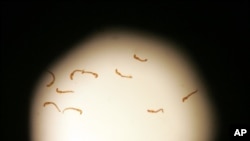The World Health Organization has published new recommendations for treatment of very young children with schistosomias after studies throughout Africa showed a drug given to older patients also works well in infants.
Schistosomiasis, also known as snail fever, claims 200,000 lives per year and mostly occurs in sub-Saharan Africa, but the disease is also found in Asia, the Middle East, and South America. It is caused by a parasite that swims freely in many lakes and streams.
On contact with humans, it burrows into the skin and eventually migrates to the lung, liver and other parts of the victim’s body. Symptoms of infection can range from fever, chills and itching to abdominal pain, bloody diarrhea and brain seizures. In children, chronic infection can cause anemia and impair mental and physical development.
In areas where schistosomiasis is endemic, school-age children routinely get an annual dose of a drug to protect them against infection. But until now, the assumption was that younger children weren't exposed to the parasite and didn't need the medicine.
However, University of Edinburgh researcher Francisca Mutapi says preschool-age children are, in fact, getting infected. It happens when mothers and other caregivers bring them along when they do chores beside parasite-infested rivers. The youngsters often play in the water and pick up the parasite.
"And once they become infected, actually they begin to show signs of infection and damage as a result of infection," she said. "So, for example, poor cognition, poor memory. And by the time they get to school, age six or seven, it may already be too late for some of these children, because they already have infection."
So scientists conducted studies in six African countries to see if the standard schistosomiasis drug, praziquantel, was safe and effective in children age five and younger.
The research, including Francisca Mutapi's study in her native Zimbabwe, was reviewed by World Health Organization experts, who are offering updated recommendations in a WHO publication.
"The treatment with this drug was safe. And most importantly, it was efficacious. The level of reduction in infection and in morbidity that you saw in the older children was reproduced in this young age group," Mutapi said.
She added that the drug is cheap - half a U.S. dollar or less for the once-a-year dose. It is also very cost-effective, since it can dramatically improve prospects for children who might otherwise be handicapped by impaired mental function.






